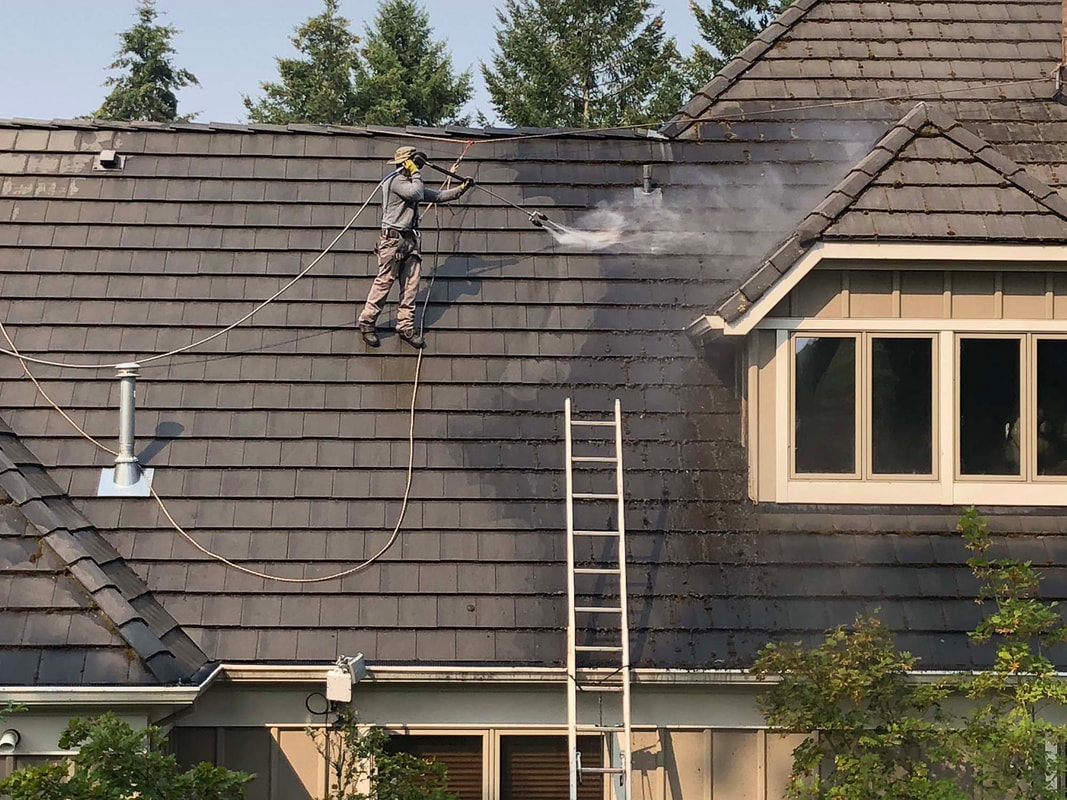
If your roof has gone from crisp and clean to streaky, stained, and speckled with moss or algae, you’ve probably wondered: Can I pressure wash it? It seems like the fastest way to blast off all that grime—right?
Here’s the truth: Pressure washing a roof can be very risky if done incorrectly. While it’s possible to clean a roof using water pressure, the technique, tools, and timing are critical. 🧠⚙️
Let’s break down the risks, alternatives, and best practices for safely getting your roof looking brand new—without causing costly damage. ✅
🚫 The Risk: Why Pressure Washing a Roof Can Be Dangerous
Roofs are tough against rain, sun, and snow—but they’re not designed to withstand high-pressure water blasting them from up close. A standard pressure washer can produce between 2,000–4,000 PSI, and that kind of force can:
- Loosen or break shingles
- Strip off granules from asphalt shingles (shortening the roof’s lifespan)
- Force water under shingles, causing rot or mold
- Damage flashing, vents, or sealants
- Voids your roof warranty in many cases ❌
In short: High pressure + shingles = bad idea.
🧱 Which Roof Types Are Most at Risk?
Not all roofs are created equal. Here’s a quick rundown:
- Asphalt shingles: Most vulnerable to damage from high PSI
- Wood shakes: Can be splintered or dislodged
- Tile (concrete/clay): Brittle—can crack or break with pressure
- Metal roofs: More durable but still require care with seams and screws
So unless you have a metal or flat rubber roof, pressure washing should be avoided—or done very cautiously. 😬
🧼 So What’s the Right Way to Clean a Roof?
For most residential roofs, the soft wash method is the safest and most effective option. This involves:
- Low-pressure spraying (under 500 PSI)
- Using specialized cleaning solutions to kill algae, moss, and mold
- Letting the chemicals dwell and do the work
- Gentle rinsing or natural rain runoff to carry away debris
This method is recommended by roofing manufacturers and pros because it preserves the roof while still cleaning thoroughly. 🌿🧴
Browse Amazon Here For Soft Washing Equipment And Accessories
🧴 What Kind of Cleaner Should Be Used?
Look for roof-safe cleaners labeled for:
- Algae and mildew removal
- Moss and lichen control
- Asphalt or composite roofs
Common ingredients include:
- Sodium hypochlorite (bleach-based)
- Surfactants to help the solution stick
- Biodegradable agents to minimize environmental impact
⚠️ Always protect nearby landscaping by covering plants and thoroughly rinsing them before and after application.
Browse Amazon Here For Biodegradable Pressure Washing Detergents
🪜 Should You Do It Yourself?
Cleaning your roof is not the ideal DIY project, unless you’re very experienced with ladders and safety harnesses. It’s easy to slip, fall, or damage the roof if you’re not careful.
🚫 Avoid walking directly on shingles unless necessary.
Hiring a professional who uses soft wash equipment is often the best route—they’ll have the right tools, safety gear, and insurance in case something goes wrong.
✅ Signs It’s Time to Clean Your Roof
- Black streaks (from algae) running down your shingles
- Green patches (moss or lichen) growing along edges or in shady spots
- Dull or discolored shingles
- Visible debris, leaves, or mold from nearby trees
These issues not only hurt your curb appeal but can also shorten your roof’s lifespan and reduce home value.
🧠 Final Thoughts
So, is pressure washing safe for roofs? Not in the traditional sense. High-pressure washing can do more harm than good on most roofs. But that doesn’t mean you’re stuck with stains and moss forever. 🌧️💡
To recap:
- 🚫 Avoid high-pressure washing on asphalt, wood, or tile roofs
- ✅ Use soft wash techniques with roof-safe cleaners
- 🛠️ Consider hiring a professional, especially for multi-story homes
- 🌱 Always protect plants and gutters from chemical runoff
A clean roof doesn’t have to come at the cost of a damaged one. With the right method, you can keep your roof looking great—and performing its best—for years to come. 🏡✨
Browse Amazon Here For Popular Pressure Washers And Accessories






